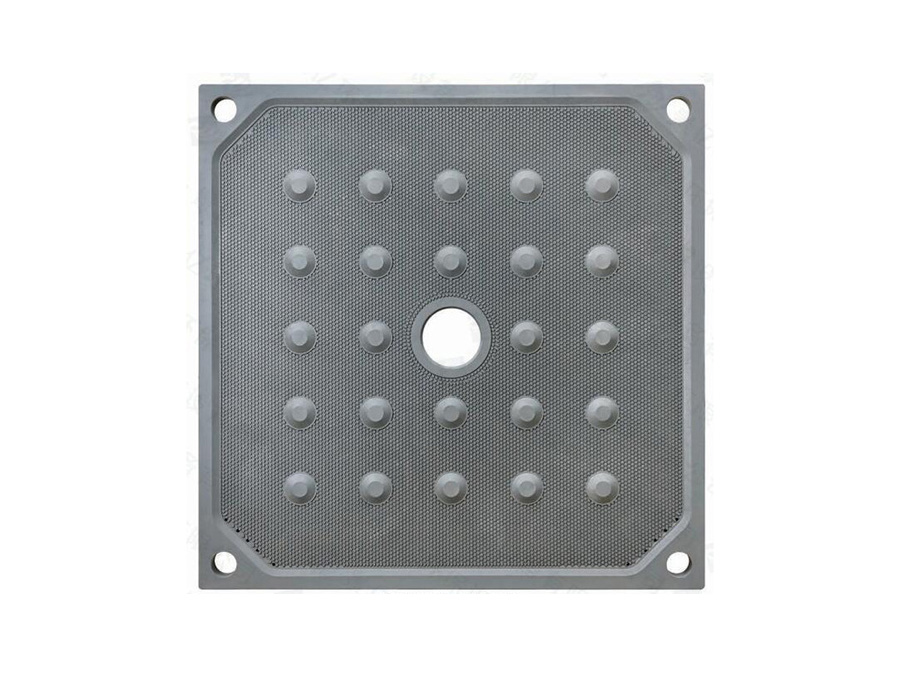ProductsDetails

2000 Polypropylene High-pressure Diaphragm Chamber Filter Plate
Structural Features
Dimension Specifications: Usually, the external dimensions are approximately 2000×2000mm, the thickness is around 80mm, and the diameter of the central feeding hole is about 245mm.
Basic Structure: It has the basic structure of a chamber filter plate. There are sealing grooves around it, into which sealing rubber strips can be installed to ensure that a closed filtering chamber is formed during the filtration process and prevent the filtrate from leaking. The surface of the filter plate is equipped with drainage grooves, which are used to guide the filtrate to flow out from the filter cloth and be discharged from the filter chamber through the drainage holes.
Diaphragm Structure: Different from ordinary chamber filter plates, it is equipped with a retractable diaphragm structure. During the filtration process, after the feeding is completed, high-pressure fluid medium can be injected into the diaphragm filter plate. The diaphragm sheet on the diaphragm will bulge out, thus squeezing the filter cake and achieving further dehydration of the filter cake.
Material Characteristics
The main material is polypropylene, which has the following characteristics:
High Strength: It can withstand relatively high pressure, maintaining structural stability during the filtration and pressing processes, and is not prone to deformation or cracking.
Corrosion Resistance: It has good tolerance to most chemical substances such as acids, alkalis, and salts, and is suitable for handling various corrosive materials, such as chemical solutions in the chemical industry, electroplating wastewater, etc.
Temperature Resistance: It can work stably within a certain temperature range. Generally, it can withstand a temperature range of 0-95°C, and the temperature range of some diaphragm materials may be wider.
Good Toughness: This enables the filter plate to be less likely to experience problems such as brittle cracking during frequent pressurization and depressurization processes, thus prolonging its service life.
Working Principle
Filtration Stage: When the filter press is in operation, a certain number of filter plates are closely arranged under the action of strong mechanical force, and a filter chamber is formed between the inner cavities of the filter plates. The material to be filtered is fed into the filter chamber under the specified feeding pressure. The solid part of the material is intercepted by the filtering medium (such as the filter cloth) and forms a filter cake on the surface of the filter plate. The liquid part passes through the filtering medium, and is discharged from the filter chamber through the drainage grooves and drainage holes on the filter plate, realizing solid-liquid separation.
Pressing Stage: After the filtration is completed, high-pressure fluid medium, such as compressed air or water, is injected into the diaphragm filter plate. The diaphragm sheet on the diaphragm bulges outward under the action of pressure, squeezing the filter cake in the filter chamber, further squeezing out the water in the filter cake, reducing the moisture content of the filter cake, and improving the solid-liquid separation effect.
Application Fields
Chemical Industry: It is used for solid-liquid separation in the production processes of various chemical raw materials and products. For example, in the filtration links of the production of dyes, pigments, fertilizers, etc., it can effectively separate solid impurities and improve product purity.
Environmental Protection Field: It is widely used in sewage treatment, sludge dewatering, etc. It can efficiently handle a large amount of sewage and sludge, separate the solid pollutants in them, facilitate subsequent treatment and disposal, and reduce environmental pollution.
Food Industry: For example, in the processes of sugar making, wine brewing, and soybean product processing, it is used to separate solid residues and liquids, ensuring the quality and taste of products, and at the same time realizing the recycling of resources.
Pharmaceutical Industry: In the pharmaceutical production process, it is used to filter and separate various liquid medicines, intermediates, etc., to remove impurities and solid particles, and ensure that the purity and quality of medicines meet the standards.
 Recommended News
Recommended News
-
Master These Tips, Easily Solve Common Faults of Diaphragm Filter Press Plates
2025-04-28 12:03:11
-
Unveiling Methods to Prolong the Service Life of Diaphragm Filter Press Filter Plates
2025-04-26 09:51:45
-
Key Points of Routine Maintenance for Diaphragm Filter Press Filter Plates
2025-04-25 05:13:34
-
What Are the Advantages of Highly Elastic Diaphragm Filter Plates in Filter Presses?
2025-04-24 03:04:12
-
Do you know about the diaphragm filter plate of a filter press with high-efficiency filtration capabi
2025-04-23 12:18:11
 Contact us
Contact us
—— Contact:Manager
—— Tel:+86 16632826789
—— Email:sales@hbscfilterpress.com
—— Url:http://www.hbscfilterpress.com
—— Address:West Zone of Economic Development Zone, Fucheng County, Hengshui City, Hebei Province









